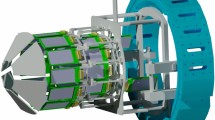Abstract.
We report on the development of a new, portable detector array for charged particles with a low detection threshold to study the reaction mechanisms of exotic nuclear systems at energies around the Coulomb barrier. In order to identify both light and heavy particles simultaneously, the array consists of ten units of \( \Delta E\)-\( E_{\mathrm{R}}\) telescopes, where each one is made up of four detection layers: one ionization chamber, one 40 (or 60)μm double-sided silicon strip detector and two quadrant silicon detectors with thicknesses of 300μm and 1000 (or 1500)μm, respectively. The frame of the ionization chamber is innovatively designed with printed circuit boards, thus the mass of each telescopic unit was reduced significantly which eases transport and installation requirements to different radioactive ion beam lines around the globe. The commissioning experiments focused on elucidating several reaction mechanisms encountered in the 17F + 58Ni and 17F + 208Pb systems, and we demonstrated that the array has a sufficient capability to enable charged particle identification over a large range of Z. Light particles like p, d, \( \alpha\) as well as heavy ions like 16O and 17F can be clearly distinguished. Considering these properties, this newly developed array enables in-depth investigation of the novel reaction mechanisms which are manifested in the collisions of exotic nuclei with differing isotopes.
Similar content being viewed by others
References
I. Tanihata, Prog. Part. Nucl. Phys. 35, 505 (1995)
I. Tanihata, Prog. Theor. Phys. Suppl. 146, 1 (2002)
A. Ozawa et al., Phys. Rev. Lett. 84, 5493 (2000)
C. Signorini, Nucl. Phys. A 693, 190 (2001)
Y. Blumenfeld et al., Nucl. Instrum. Methods Phys. Res. A 421, 471 (1999)
E. Pollacco et al., Eur. Phys. J. A 25, 287 (2005)
G. Marquinez-Duran et al., Nucl. Instrum. Methods Phys. Res. A 755, 69 (2014)
M. Romoli et al., IEEE Trans. Nucl. Sci. 52, 1860 (2005)
M. Romoli et al., Nucl. Instrum. Methods Phys. Res. A 266, 4637 (2008)
E. Strano et al., Nucl. Instrum. Methods Phys. Res. B 317, 657 (2013)
D. Pierroutsakou et al., Nucl. Instrum. Methods Phys. Res. A 834, 46 (2016)
J.Pouthas et al., Nucl. Instrum. Methods Phys. Res. A 357, 418 (1995)
K. Kwiatkowski et al., Nucl. Instrum. Methods Phys. Res. A 360, 571 (1995)
I. Iori et al., Nucl. Instrum. Methods Phys. Res. A 325, 458 (1993)
N.R. Ma et al., Chin. Phys. C 40, 116004 (2016)
Z. Sun et al., Nucl. Instrum. Methods Phys. Res. A 503, 496 (2003)
J.J. He et al., Nucl. Instrum. Methods Phys. Res. A 680, 43 (2012)
S. Kubono et al., Eur. Phys. J. A 13, 217 (2002)
Y. Yanagisawa et al., Nucl. Instrum. Methods Phys. Res. A 539, 74 (2005)
X.X. Xu et al., Nucl. Sci. Tech. 29, 73 (2018)
L.J. Sun et al., At. Energy Sci. Technol. 49, 336 (2015)
P.F. Bao et al., Chin. Phys. C 38, 126001 (2014)
S. Agostinelli et al., Nucl. Instrum. Methods Phys. Res. A 506, 250 (2003)
H. Yamaguchi et al., Nucl. Instrum. Methods Phys. Res. A 589, 150 (2008)
H. Kumagai et al., Nucl. Instrum. Methods Phys. Res. A 470, 562 (2001)
L.J. Sun et al., Nucl. Instrum. Methods Phys. Res. A 804, 1 (2015)
L.J. Sun et al., Phys. Rev. C 95, 014314 (2017)
X.X. Xu et al., Phys. Lett. B 766, 312 (2017)
L. Yang et al., Phys. Rev. C 95, 034616 (2017)
L. Yang et al., Phys. Rev. C 96, 044615 (2017)
L. Yang et al., Phys. Rev. Lett. 119, 042503 (2017)
J.F. Ziegler, M.D. Ziegler, J.P. Biersack, Nucl. Instrum. Methods Phys. Res. B 268, 1818 (2010)
Y.Y. Yang et al., Nucl. Instrum. Methods Phys. Res. A 701, 1 (2013)
G.X. Zhang et al., Nucl. Instrum. Methods Phys. Res. A 846, 23 (2017)
G.L. Zhang et al., Nucl. Sci. Tech. 28, 104 (2017)
G.L. Zhang et al., Phys. Rev. C 97, 044618 (2018)
R.S.S. Fernbach, T.B. Taylor, Phys. Rev. 75, 1352 (1949)
M. Mazzocco et al., Phys. Rev. C 82, 054604 (2010)
J. Lei, A.M. Moro, Phys. Rev. Lett. 122, 042503 (2019)
E.F. Aguilera et al., Phys. Rev. Lett. 107, 092701 (2011)
A. Gavron, Phys. Rev. C 21, 230 (1980)
P. Amador-Valenzuela et al., J. Phys. Conf. Ser. 492, 012003 (2014)
Author information
Authors and Affiliations
Corresponding author
Additional information
Communicated by T. Motobayashi
Data Availability Statement
This manuscript has no associated data or the data will not be deposited. [Authors’ comment: Part of the data generated during this study are contained in this published article. All data will be published after the data analysis is finished.]
Publisher’s Note
The EPJ Publishers remain neutral with regard to jurisdictional claims in published maps and institutional affiliations.
Rights and permissions
About this article
Cite this article
Ma, N.R., Yang, L., Lin, C.J. et al. MITA: A Multilayer Ionization-chamber Telescope Array for low-energy reactions with exotic nuclei. Eur. Phys. J. A 55, 87 (2019). https://doi.org/10.1140/epja/i2019-12765-7
Received:
Accepted:
Published:
DOI: https://doi.org/10.1140/epja/i2019-12765-7




